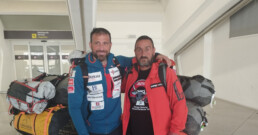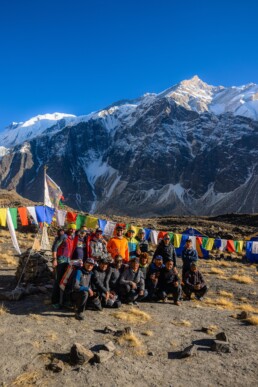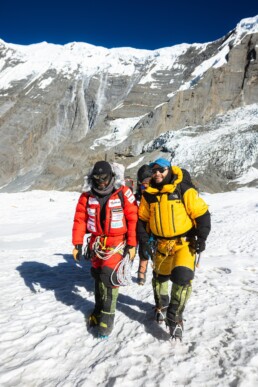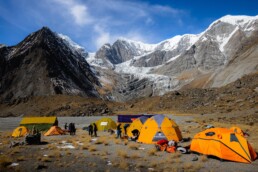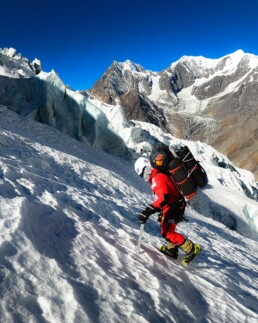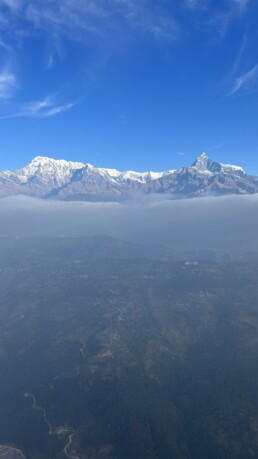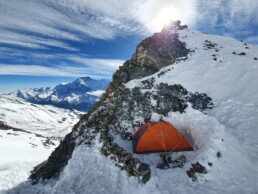Thank you for following me every step of the way. You are part of my backpack
One more expedition showing unconditional support, one more time backing the winter projects we are immersed in. Thank you for the commitment, the contribution, my sincere thanks to the sponsors and collaborators who guarantee our adventures.
Your support has been fundamental to make this project possible, I feel fortunate to have such bold allies whose commitment is unwavering. My deepest gratitude for your generosity and continued support.
I would also like to thank all the people who follow me on social networks, in the blog of the website alextxikon.com and the media, the journalists who echo my progress in the mountains.
We will continue to strive to achieve our goals and objectives.
Eskerrik asko, gracias, Thank you, Grazie, Dhanyabad
Chronicles from Annapurna chapter VI
Today, January 13, maybe we should be higher, but for some reason we are not, surely we have not been smart enough or effective enough on Annapurna 8091mt. Why? Because we have reached Camp 3 three times, and we will not do it any more times. In spring, Annapurna is usually climbed with a single rotation to reach the summit, and two of us have even climbed the great Colouir four times.
Why are we talking about the great Colouir? To get an idea, it is one of the most dangerous and crazy places you can imagine, if an avalanche catches you, it releases shrapnel in blocks of ice of different sizes, bigger than a car. That wipes you off the face of the earth ipso facto, we have taken too many risks already, one thing is that it catches me, but not my companions. This time I got off doubly (two avalanches almost made us stop breathing). The Annapurna has told us enough, we have tried, we have the strength and desire, but maybe I lack hunger for the summit, to get 1 year ago the summit of Manaslu, probably we lack hunger for the summit, but as I said, one thing is that all those present are mainly here for me, and if I go, nothing happens, another thing is that they go, that is not a good person to satiate our ego of summit.
We fought for it, we carried everything ourselves, we equipped everything ourselves. I made a mistake by myself and we all got up. I think that to stay would be reckless given the exceptionally good conditions, but at the same time so compromising and risky. Annapurna is in constant transformation, and it is so bare, which makes it a fragile and threatening mountain wherever we pass. In addition, the sky, except for the last two days does not stop roaring, I can not afford to expose more to my companions and so after talking and meditating all morning, we decided to give a yes to life guaranteed, and leaving behind our pretensions to continue trying.
Special thanks to all my colleagues, Chhepal, Magkpa, Ang-gyalu, Mayla, MigTemba, Lakpa, Tashi, Moeses, Mattia, Eneko, Andres, 7summits staff, we have suffered and also enjoyed, to those who have followed us and to sponsors and friends.
Graccie mile, obrigado , eskerrik asko, gracias, dhan'yavāda
Chronicles from Annapurna chapter V
The whole team of climbers is now at the BC of Annapurna, having reached C3 (6,400m) this morning on the third high altitude rotation of their #AnnapurnaColdPeaks winter expedition. Unfortunately, upon arrival they found that the deposit (stakes, ice screws, 2,000 meters of rope, gas, 3 snowbound tents) had "disappeared", due to the collapse of one of the ice structures.
According to the biscayan, "we have lost the entire C3 deposit, and not because of the wind, but because of the collapse of one of the ice structures that has caused the disappearance of practically all the material we had in this camp, except for some coils of rope".
Specifically, what has happened is that "the area where the deposit was located in C3 has given way, forming a crack through which all the material has been lost. This is a complex terrain, with a set of seracs that could resemble an icefall. The way Annapurna is at the moment, with no precipitation and very low temperatures, there is practically no safe place," says Txikon. This has forced the whole team to return to BC.
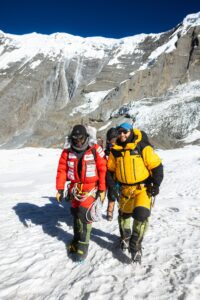
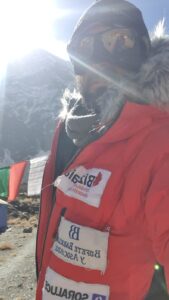
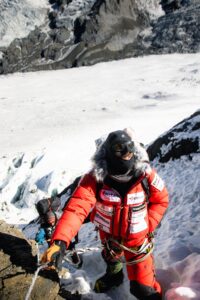
Chronicles from Annapurna chapter IV
Our cook and Base Camp coordinator Eneko Garamendi shows us the guts of the BC of Annapurna (4,200 meters), where we rest and prepare the strategy to attack the summit in the coming days. As you can see, this temporary refuge is the nerve center of the expedition where we meet to regain strength, plan the ascent, analyze the weather reports, chat, organize the graphic material for the press and eat together. It is from here that the ascent starts and it is as important an enclave as the summit itself. I hope you enjoy this brief tour of the camp.
Chronicles from Annapurna chapter III
We left the base camp on December 23, and, to tell the truth, we did it without a clear objective, just to continue working. When we left BC, around 10:00 A.M., my backpack was closer to 30 kilograms than 25 kilograms. But I started to remember what we did in 2010, with the Alfilo team, then led by Edurne Pasaban. It made me go out in a daze, remembering what was undoubtedly my best spring, with the Annapurna and Shisha Pagma double a month later!
Before 15:00 p.m. we were at C1, at 5,150 meters, and with more than 1,000 meters of positive vertical drop.
We spent two nights at C1, as we took the opportunity to mark the entire route of the glacier crossing with bamboo flags. In the meantime, we spent Christmas Eve having rice with lentils for dinner, and we really had a great time.
Yesterday, December 25, we went out in two different groups, again carrying another 25 kilograms. We set up the C2 at about 5,600 meters, although I admit that I do not like this camp very much. This kind of location on a slope invites you to think about it all night long, until you get used to it.
Today, I left the tent at 7:30 a.m. and, after organizing the whole team, we headed up in strong gusts of wind. The gusts, fortunately, were not constant. We set off with 1,200 meters of rope, gear, two snowbound tents and three tents to set up at C3.
As I said at the beginning, we have spent four days and three nights at altitude, in which the team, composed of eight people, had to make a superhuman effort, carrying and equipping the route to C3. Thus, we now have the key to attempt the summit.
If we had been told when we arrived at BC on December 22nd that four days later we would be able to reach the C3, we would not have believed it, and we still don't believe it. The weather has also helped us, but the truth is that nothing has been given to us. And I emphasize that, four days after the beginning of the astronomical winter, the fact that we are in C3 is very good news.
The problem we already know what it is: as all these years ago, as soon as the mountain says no, it will be no. In the meantime, we will enjoy all that we have to offer. In the meantime we will enjoy everything we are doing.
Thank you very much for your support. Here we continue with our motivation through the roof. We will be heading up again in a couple of days.
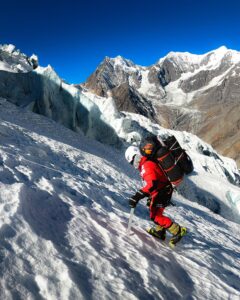
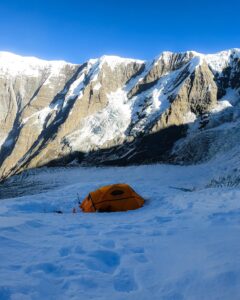
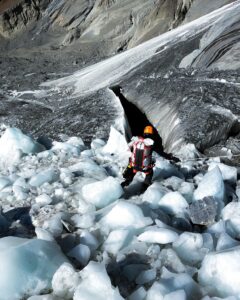
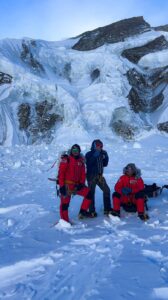
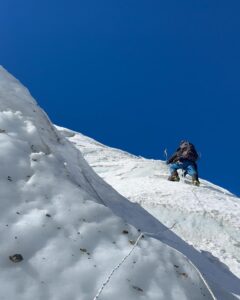
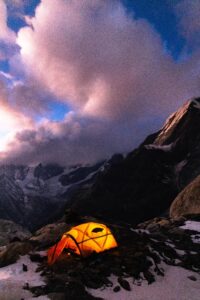
Chronicles from Annapurna chapter II
Today, 20 December, we are leaving Pokhara for base camp on the north side of Annapurna at 8,091 metres. On expeditions, unforeseen events often occur, with the problems that they cause. However, with the experience we have, we gather our courage and continue step by step, because we are aware that the road is a long one.
In the next few days, exactly on December 22, we hope to reach base camp, at 4,200 metres, right at the beginning of the astronomical winter, as in all our winter expeditions, which we have always followed at the beginning of the winter.
There is no consensus about winter expeditions, there are many opinions about these expeditions; therefore, it is becoming more and more common to find in press articles, and even in the specialised press, aspects that are not at all accurate. This leads us to fall into subjectivities, for example, depending on the nationality of the ascent. Sometimes it is elevated to the Olympus, while in some cases it is attributed minimal importance.
We are lucky, because we do it for and by ourselves, which makes the terrain easier for us. However, to be honest, since 2010/11, during the first attempt at winter, we realised that the weather conditions are much more favourable in December. In March, the temperatures start to improve substantially, so the worst conditions start in January and February. I say this in order to seek a consensus where each and every opinion leads us to the same starting point.
In my opinion, it would be a good idea for all the invited actors in this Himalayan discipline to start building a story, where each and every opinion is taken into account. In this line, instead of destroying, it would be good to build, opening an ethical debate in which we understand what a winter expedition is, why they are born, where and when it all began.
If all goes well, as I have already mentioned, we will reach base camp on December 22, and without delay, we will start to work on the mountain, we will start to play in and with it, which, after all, is what we have come for, to have fun and enjoy ourselves as much as possible.
Although many people do not understand the benefits of an expedition like this, I would like to confess that we, and I in particular, are so passionate about what we do that we are capable of risking our lives to get to the top of it. To gain, more than anything else, our own freedom, achieving our goals and boosting our ego to the max, by carrying out the most selfish act we can undertake.
In the coming days and weeks, we will see how far our experience (interspersed with some good fortune) and our desire and motivation will take us.
We will send the first photographs and impressions on our arrival at base camp.
Best regards and see you soon.
By the way, I would like to highlight the work of the porters before we meet them. They are the ones who will carry all the loads for a couple of days until we reach base camp. I would like to thank each and every one of them for their effort and commitment, because without them it would not be possible. I would also like to thank our sponsors, as their help, as well as that of all the people who are watching us, is essential.
A big hello from Pokhara.
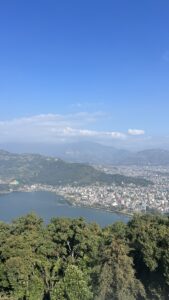
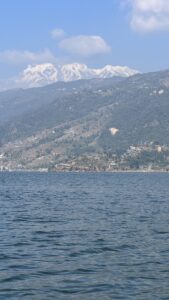
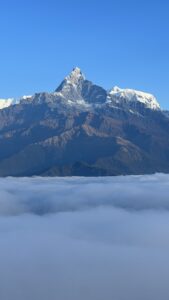
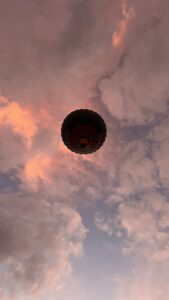
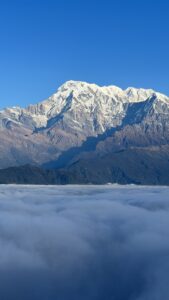
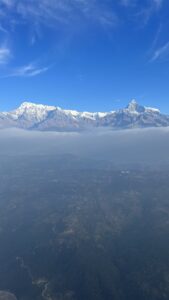
Chronicles from Annapurna chapter I
We are approaching the beginning of the astronomical winter, the time when we started our winter expeditions back in 2010-2011. The first question is: why in winter? And then I ask myself: why not in winter? In my evolution as a person and, in this case, more specifically, as a mountaineer, I decided to discover what winter would be like, I wanted to know how to act, what it would be like to climb a mountain in the Himalayas at the hardest and most challenging time of the year, when the mountains are at their most beautiful, and the winter purity and solitude trap you, where one has to be much more intelligent and astute.
This year, we decided to leave home on 29 November, and we have been at quite high altitudes since 2 December. We have slept at more than 5,000 metres on almost half a dozen nights, and we have been at 6,000 metres, that is, at high altitudes that make us much more confident.
If all goes well, we will leave Pokhara on the 21st of December in the direction of Dana to reach Humkhola. The journey is estimated to take about 6 hours by four-wheel drive. From there we will walk to the base camp, which, if I remember correctly, we set up at about 4,200 metres back in 2010.
For those who might think that climbing in winter, spring or autumn is the same thing, just with the uncertainty we have, I say little. In spring and autumn, it is certain to find water at base camp; however, in winter, we have doubts that we will be able to set up base camp at 4,200 metres, as, with hardly any rainfall in recent weeks, it is more than likely that there will not be enough snow, and on the plane where we plan to set up base camp at this time, it is not certain that the water will be flowing.
So the first question is where to set up base camp, which may be at about 3,800 metres, about 2 or 3 hours below where the base camp is usually set up, because there, at least, we are sure to find a lake. At that point, if we are 100% sure to find water or the same frozen lake.
The Annapurna that we will encounter in the coming days will be different from what we already know, because the mountains in the Himalayas change; Everest in the 3 attempts we made in winter was nothing like what we knew, as it was in the last 3 winters on Manaslu. The mountain is there, but it is not the same. However similar the conditions are, the wind, the accumulations of snow throughout the year, depending on how they have fallen, etc., make them change completely, they are different, but, at the same time, they are much more aesthetic.
If everything goes as it has so far, we will be arriving at base camp on 21 December, with the onset of astronomical winter, to set up the base camp, and, without further ado and with our knives between our teeth, as always, to work hard, in order to have a chance. If he grants it to us, well and good. If not, we know what this is all about, we need only look at our statistics. They are not very encouraging, but we know that, if they were easy, more people would be encouraged to visit them and the summits would even be reached more often in winter.
Here you can enjoy some pictures of the village of Nagual, at 3,600 metres, where we spent several nights. From there, we set off for Far Chulu East base camp at 4850m. We spent one night there before making our way to Hi Camp at 5,300m, making our way up, enjoying the solitude and the beautiful views. Finally, we slept in a last bivouac at 5,650 metres, where we spent a hard and terrible night, because the air was blowing very hard. This caused me to spend almost the whole night without sleeping because of the intensity of the air. The next destination was the summit ridge. There, the wind definitely stopped us. We know what this is all about, "when in doubt, the safest way".
It was a privilege to share these moments with friends. It was a shame, because I was the one who decided to turn back, and I feel very sorry for Jabitxu, but that's the thing about the mountains; you have to know how to turn back, especially when they are warning you at more than 75km/hour. There is a fine line between living and dying, and between being well and getting into trouble (real trouble). That is the real key to success.
I also leave you these pictures in which, together with Mattia and other friends, we have had a great time. I would like to encourage you to follow our next adventure.
As far as we know, only Denis Urubko has announced that he will attempt g1 in the winter. More than a decade ago, in 2010-2011, I enjoyed the historic g2 ascent of Cory, Denis and Simone, and I have nothing but words of encouragement for Denis, and good luck to each of the greatest himalayists of the moment. The same or more than we will need.
Between today and tomorrow we will gather the rest of the team that is now slightly scattered. This year we have the presence of Andres Navamuel as cameraman, who comes from the Khumbu trek, where he has learnt first-hand what altitude is like and the punishment it entails. Eneko lands tomorrow. So, the whole group will get together and we will go from 20 degrees in the sun in Pokhara, to enter Annapurna, a mountain that we already climbed on April 17, 2010.
Greetings to all of you, and cheers!
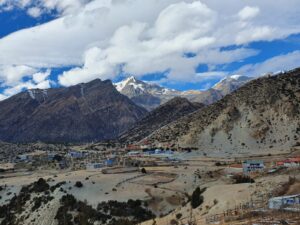
Photograph of the view from Nagwal at 3,600 meters in the Annapurna massif with the Chulus in the background.
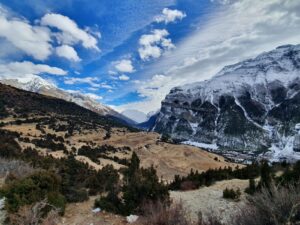
Views from Nagwal valley below. Beautiful sky
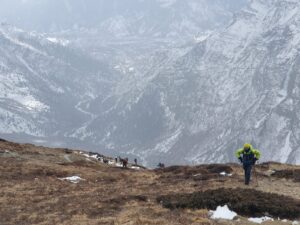
Mattia Conte and the rest of the team in ascent, at about 4,600 meters towards the 6,059 meters Far Chulu East Base Camp.
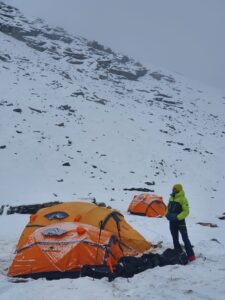
Mattia Conte at Far Chulu East Base Camp at 4,850 meters, with unstable weather and light snowfall.
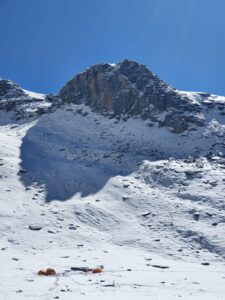
Location of the Far Chulu East Base Camp at 4,850 meters (15,000 feet)
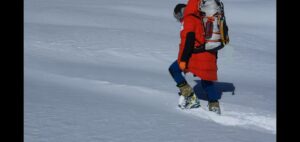
Alex Txikon, quite loaded, opening track from Base Camp to Hi Camp at 5,200 meters
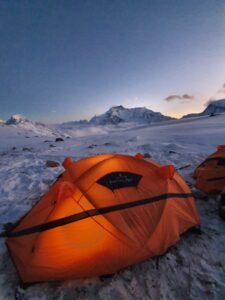
Hi Camp tents at 5,300 meters with Annapurna II in the background
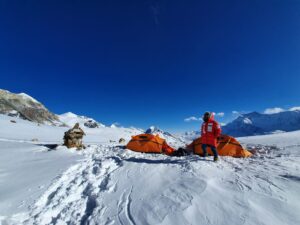
Alex at Hi Camp at 5,300 meters, behind Annapurna II
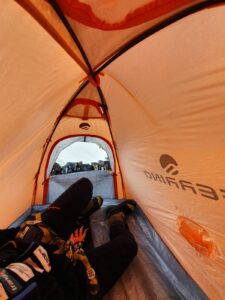
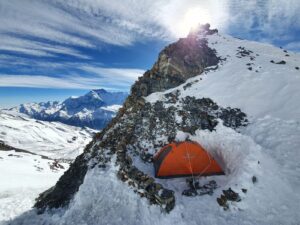
Bivouac at 5,650 meters
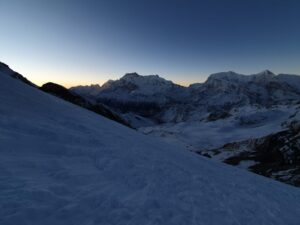
Sunrise above 5,800 meters
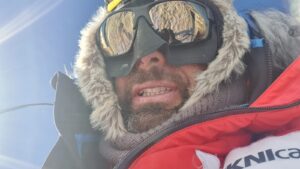
Suffering the harsh gusts of more than 70 km per hour
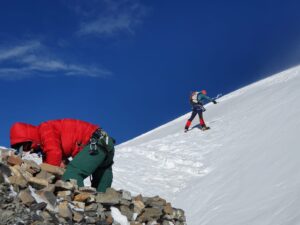
Jabitxu and Ang-Gyalu reaching the bivouac at 5,650 meters
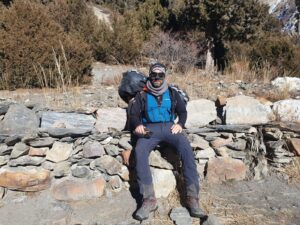
Alex after spending the night in the bivouac at 5,650 meters with the rest of the team carrying more than 40 kg in yak Kharka. No matter how hard you try to achieve your goal, no matter how hard you try it will probably not be enough, as it was in our case. But it has served as motivation and we had a great time

